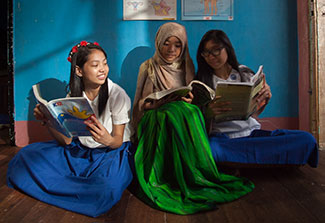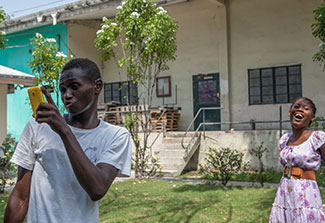HIV/AIDS a key battleground for teen health researchers
March / April 2018 | Volume 17, Number 2

(c) 2014 Froi Rivers, courtesy of Photoshare
Young adolescent girls read lesson books in Manila, Philippines.
By Karin Zeitvogel
With AIDS-related illnesses claiming more adolescent lives than any other cause except road accidents, HIV has become one of the key battlegrounds for adolescent health researchers. A majority of adolescents who died of AIDS-related illnesses in 2013 acquired HIV from their mothers, but 40 percent of all new infections each year occur among adolescents in resource-poor settings, UNAIDS says. Most of those new infections affect girls, particularly those who are socially marginalized, live in poverty and have an unstable family life.
Exacerbating the youth HIV crisis is the fact that only a small fraction of the five million adolescents living with HIV globally have been tested for the virus. Youth who are unaware that they are infected do not seek care, don't begin antiretroviral therapy (ART), and may start or continue to have sex and transmit HIV.
Haiti's teen HIV clinic boosts adherence
Haiti has the highest HIV infection rate in the Western Hemisphere, but only 9 percent of adolescent females and 4 percent of adolescent males know their HIV status. A Fogarty-supported project that recruited more than 3,300 adolescent slum-dwellers for HIV testing found that the prevalence rate among youth was 2.65 percent - nearly seven times higher than the estimated national adolescent HIV prevalence (0.4 percent) and more than half a percentage point higher than adult prevalence (1.9 percent). Nearly three-quarters of adolescents who tested positive for HIV were female, according to an analysis of the data collected by researchers from Weill Cornell Medical College and the Haitian Study Group for Kaposi's Sarcoma and Opportunistic Infections (GHESKIO), who led the study.
Adherence to antiretrovirals is also low among Haitian adolescents. To overcome that, GHESKIO scientists led by Fogarty trainee, Dr. Vanessa Rouzier, turned sessions at a youth-specific HIV clinic that's been operational since 2009 into social events "with doctor stuff tagged onto the group gathering," said Dr. Dan Fitzgerald, a longtime Fogarty grantee and the head of Weill Cornell Medicine's Center for Global Health, which for decades has partnered with GHESKIO to fight HIV/AIDS in Haiti.
A year after launching a pilot study of these mixed social and medical sessions, only around 10 percent of youth had dropped out of care, compared to around half before the peer group meetings were introduced. The pilot study has led to a larger project called FANMI - Haitian Creole for "my family" - targeting HIV-infected adolescent girls, "who we need to be tailoring our interventions for," said Fitzgerald. Supported by NIH's
National Institute of Child Health and Human Development (NICHD), FANMI delivers peer group counseling, social activities and clinical care to HIV-infected girls in a community center rather than a medical clinic.

Photo courtesy of GHESKIO
Stopping the spread of HIV among teens is a critical global
issue that Fogarty-funded researchers are working to address.
FANMI and other youth-focused HIV projects are a recognition by GHESKIO that "we urgently need adolescent-specific strategies to help these youth cope and thrive with this disease, as well as prevent new infections in that group," said Rouzier. With Fogarty support, GHESKIO is also building research capacity to prevent AIDS-related cervical cancer, of which Haiti has the highest incidence in the world. Researchers are being trained in all aspects of human papillomavirus (HPV) infections in teenage girls, including behavioral, social and ethical issues, and how to administer HPV vaccination programs for this at-risk age group.
School: a powerful determinant
In Rakai, Uganda, poverty has fallen, high school enrollment has surged, and sexual intercourse initiation - an important risk factor for HIV, other sexually transmitted diseases, and unintended pregnancy - has been delayed, said Dr. John Santelli, leader of an NICHD-supported project that since 1994 has been collecting data on youth in this rural part of Uganda. The Rakai Adolescent Project has found that not being enrolled in secondary school was associated with higher prevalence of sexual experience and earlier initiation of sexual intercourse, especially among girls. "In many cultures, girls are married off to older men, who are much more likely to be HIV-positive," said Santelli. "Being in school means that's less likely to happen. Our study indicates that secondary school enrollment has a huge impact on HIV risk factors, incidence and prevalence."
Fogarty-supported research in rural Nigeria has similarly found that keeping girls in secondary school provided them with "a socially acceptable alternative to early marriage," said Dr. Daniel Perlman, one of the lead investigators on that project.
Across the Atlantic in Belize, which has the highest HIV prevalence rate in Central America, an in-school, peer-to-peer program helped promote HIV risk-reduction behaviors among adolescents. Fogarty-supported researchers trained teens to lead instructional sessions aimed at increasing knowledge of HIV among their peers. Seven weeks after the start of the intervention, adolescents who learned about HIV from the teen-educators had higher HIV knowledge and were more likely to use condoms than youth who went to control-group schools, where information about HIV/AIDS was provided through handbooks.
"Adolescents are a very high-risk group for HIV, but a lot of these children are not provided with even basic information about HIV," said Dr. Don Morisky of the University of California, Los Angeles, the study's principal investigator. "We need to harness peer-to-peer counselling more, especially for teens - they learn so much from their peers."
Stigma complicates HIV diagnoses for teens
Sub-Saharan Africa is home to the overwhelming majority of youth with HIV, many of whom acquired the virus perinatally. Fogarty grantee Dr. Dorothy Dow has been studying mental health issues that affect HIV-positive youth in Tanzania, such as stigma, suicide ideation, and, she discovered, the circumstances under which a teenager learns they have HIV. In one of many publications she has co-authored since she began working as a Fogarty Fellow and later grantee in an AIDS clinic in Moshi, Tanzania, Dow wrote that teens' caregivers often shield them from learning they have HIV, fearing the child is too young to understand or that knowing they are infected would cause them distress.
But 80 percent of youth interviewed for the study said they figured out on their own that they were HIV-positive. These teens were more likely to have mental health symptoms and poor adherence to antiretroviral therapy (ART) than teens whose HIV status was purposefully disclosed by an adult, said Dow.
The study is believed to be the first to look at the impact on adolescents' well-being of how, when and by whom a youth's HIV status is disclosed to them. "It's imperative to implement disclosure protocols early to reduce mental health difficulties, internal stigma, and promote ART adherence in youth living with HIV," Dow said. "We need to focus more on telling kids early that they have HIV, and on getting HIV-exposed children tested and into age-appropriate care, where their health and psychosocial wellbeing are monitored."
More Information
- Haiti:
- Belize:
- Tanzania:
- Uganda:
- About the
Rakai Adolescent Project (RAP), supported by the
National Institute of Child Health and Human Development (NICHD)
- Related publications:
-
Rising School Enrollment and Declining HIV and Pregnancy Risk Among Adolescents in Rakai District, Uganda, 1994-2013
Global Social Welfare: Research, Policy & Practice, June 2015 -
Prevalence of Sexual Experience and Initiation of Sexual Intercourse among Adolescents, Rakai District, Uganda, 1994–2011
Journal of Adolescent Health, November 2015 -
Trends in HIV acquisition, risk factors and prevention policies among youth in Uganda, 1999–2011
AIDS, January 14, 2015 -
Importance of Relationship Context in HIV Transmission: Results From a Qualitative Case-Control Study in Rakai, Uganda
American Journal of Public Health, March 12, 2014 -
Behavioral, Biological, and Demographic Risk and Protective Factors for New HIV Infections among Youth, Rakai, Uganda
Journal of Acquired Immune Deficiency Syndromes, July 1, 2013
- Nigeria:
To view Adobe PDF files,
download current, free accessible plug-ins from Adobe's website.